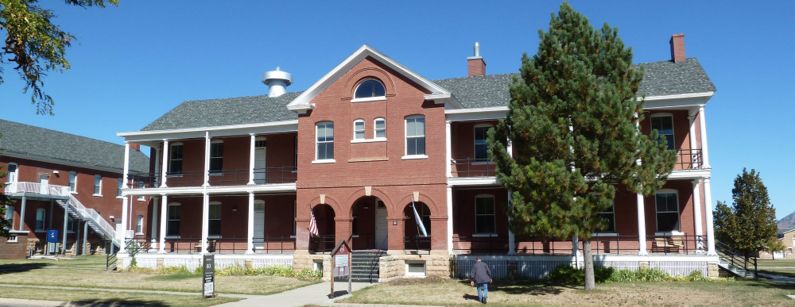Fort Meade (1)
|
Fort Meade (1) (1878-1944) - First established in 1878 as Camp Ruhlen by Maj. Henry M. Lazelle, 1st U.S. Infantry, and named after Lt. George Ruhlen (Cullum 2426), quartermaster in charge of construction. Renamed Fort Meade on 30 Dec 1878 after MG George G. Meade (Cullum 804) of U.S. Civil War fame. Transferred to the Veterans Administration in 1944 and now a VA hospital complex. HistoryEstablished 28 Aug 1878 as Camp Ruhlen by Maj. Henry M. Lazelle, 1st U.S. Infantry on a site selected by Lt. Gen. Philip H. Sheridan in present-day Meade County, South Dakota. The Fort's mission was to control hostile Sioux Indians and protect the Black Hills mining operations. Camp Sturgis was first established nearby to house the troops building the post. The troops moved to Camp Ruhlen on 28 Aug 1878 and construction began. The new post was renamed Fort Meade by the Department of Dakota General Order 27 on 30 Dec 1878. The initial post construction was complete in August 1879. The plan of the fort was reportedly laid out by General Sheridan pointing out the locations of the buildings with his sword as he rode around the site. The post was laid out around a central parade that was a rounded rectangle. The officer's quarters were on the south side, the enlisted barracks on the north side, and the administrative buildings were at the ends with a headquarters building in the center of the north side. Nine stables, each housing 86 horses, lined the north side behind the barracks. The quartermaster had a commissary and a root cellar on the west side. Most of the early buildings were frame construction and they were replaced with stone and brick buildings over the years.
World War IIFort Meade served as a training camp and a POW camp during World War II. In 1944 the post was turned over to the Veterans Administration and a new hospital complex was built north of the old post. Current StatusCurrently occupied by the Veterans Administration and the South Dakota Army National Guard. Many of the old post buildings are preserved and repurposed including many of the 1880s officer quarters and enlisted men's barracks. Seven of the original 1878-1879 buildings remain.
Sources:
Links: Visited: 24 Jun 2020, 29 Sep 2010 Picture Gallery |
||||||||||||||||||||||||||||||||||||||||||||||







